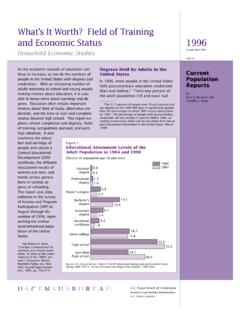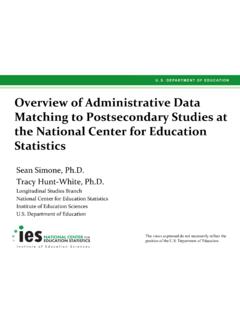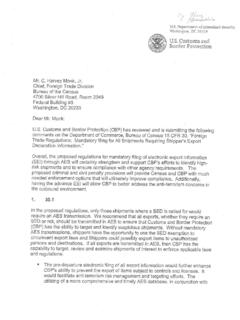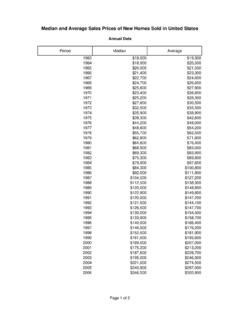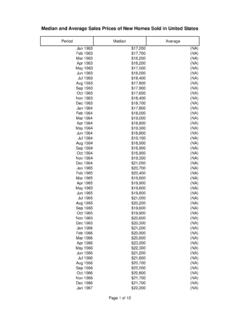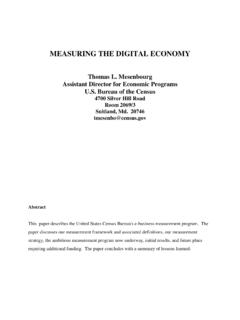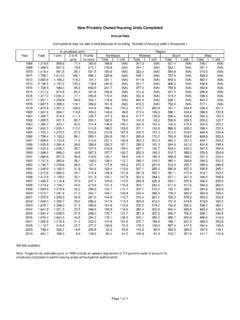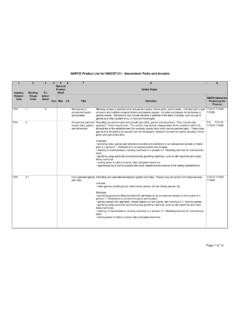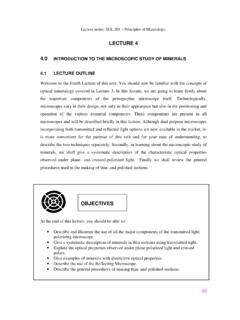Transcription of Population Projections: States, 1995-2025
1 0 Source: Bureau of the Census, Population Division, Department of CommerceEconomics and Statistics AdministrationCurrentPopulation Projections: Population ProjectionsPopulation ReportsStates, 1995 2025By Paul CampbellC E N S U S B U R E A UP25-1131 Issued May 1997 How will states populationschange in the future? All stateswill have more people (especially ithe South and West) and moreelderly as Baby Boomers report identifies populationchanges that are projected to affectthe 50 states and the District ofColumbia during the years 1995 to2025. These projections are used the basic input to many federal,state, and local projection modelsthat produce detailed statistics oneducation, economic factors, laborforce, health care, voting, and soforth.
2 The results are useful toplanners in both the public andprivate assumptions for statepopulation projectionsPopulation. State projections are consistent with the national Population State trends in age-race- Hispanic-specific fertility rates forstates parallel projected State trends in age-sex-race-Hispanic-specific survival ratesfor states parallel projected international migration. 820,000 annually, distributed by State, based on net internationalmigration rates derived from 1990census data for foreign-born personswho immigrated during the 1985-1990 internal migration.
3 Based on a time- series model using estimatesof state-to-state migration for the1975-94 period; the first 5 projectionyears use the time- series projectionsexclusively, the next 10 projectionyears interpolate toward the 1975-94 average of the time series , and the last 15 years use that average exclusively.(For detailed discussions of the assumptions and methodology used to develop Population projections, seethe report cited on p. 6.)CATXFLGAWAAZNCVANYNJILCOTNMDORS tates with the largest projected net increase inpopulation: 1995 to 2025 MillionsFigure 1. Most of the Increase is in the South and WestSource: Bureau of the Census, Population Division, 10203040506 CANMHIAZNVIDUTAKFLTXWYWAORCOGANCMTVATNSC NHMDOKARALKSNJDEMNSDLADCNEMOMSVTRIMEWICT NDMAILINKYNYIAMIOHPAWVS tates ranked by percent change inFigure StatesPercent changepopulation.
4 1995 to 20252P25 1131 More people in the South and WestOver the next three decades, netpopulation change (births minusdeaths plus net migration) will bemost evident in three states California, Texas, and Florida each of which will gain more than 6 million persons (see Figure 1 onpage 1). They will account for 45percent of the net Population changein the United States. No other statewill gain more than millionpersons. In fact, the 12 States thatwill add between million and people during this period willaccount for only 30 percent of theNation s , the most populous statewith 12 percent of the Nation spopulation in 1995, is expected tohave 15 percent of the Nation spopulation by 2025.
5 California sincrease in Population millionpeople is nearly the currentpopulation of New York natural increase, inter-national migration is expected tocontribute to California s rapid growth (Table 1).The most populous states in theSouth will continue to grow fairlyrapidly. During 1994, Texas replacedNew York as the second mostpopulous state and is expected toremain in that position throughoutthe projection period. Florida isprojected to replace New York as thethird most populous state by growth in the WestThe rate of Population changeamong the 50 states and the Districtof Columbia will vary during the late1990s.
6 Nevada is expected to havethe most rapid growth (22 percentfrom 1995 to 2000), with the Districtof Columbia at the other end of thecontinuum with a Population loss of6 percent. The most rapid rates ofchange are projected for themountain states, with rates rangingfrom 9 percent to 22 percent duringthe 1995-2000 period. Georgia, witha 9 percent rate of populationchange, is the only other stateprojected to grow this 2000, the rate of populationchange for most states will declinesubstantially, assuming that nationalprojection trends and historicaltrends in interstate migrationcontinue.
7 (See methodology detailsbirths per 1,000 Population in thePPL-47.) In contrast, California isDistrict of Columbia and California toexpected to grow faster after 2000,10 births per 1,000 Population inresulting in the highest rate ofWest Virginia during the 30 change (52 percent)The variation in mortality is expectedduring the 2000-2025 period; seeto range from 13 deaths per 1,000 Figure 2 on page 1. During eitherpopulation in West Virginia and theperiod, the fastest growing states areDistrict of Columbia to 5 deaths perin the ,000 Population in differences in fertilityand mortality to widenAlaska, California, Utah, Texas, andHawaii (in rank order) are projectedto have the highest average annualBetween 1995 and 2025, the rangerate of natural increase from 1995 toof birth rates is expected to widen2025, with rates ranging from 14slightly, reflecting the concentration ofdown to 9 persons per 1,000 pop-race and ethnic groups with highulation.
8 West Virginia and Arkansasfertility rates in some states andare the only states expecting eitherdifferential migration patterns. Fertilityno gain or a loss from naturalis expected to range from 20increase (see Figure 3 below).DE to to to to to Average Annual Rate of NaturalIncrease Per 1,000 Population : 1995 to 2025 WAORCANVNMAZTXLAIDNDSDOKKSNEWYUTCOWIMNIA INILOHKYTNMOARMSALGASCNCVAWVPANYMEAKHIMD NJCTRIMAVTNHDCMIMTFLP ercentSource: Population Division, Bureau of the Census, NetIn-Out-interstateStatesmigrantsStates migrantsStatesmigrantsDC88DC98 Florida8 Alaska72 Alaska76 Oregon7 Wyoming67 Wyoming60 New Mexico6 Nevada60 Nevada54 Nevada6 New Mexico54 Hawaii49 Wyoming6 Lowest York -9 New York15 Wisconsin19DC-10 Figure , and net interstate migrants per 1,000 populationAmericans on the MoveStates with the highest and lowest rates of in-migrants,Source: Census Bureau, Table Population and Net Change for States: 1995 to 2025[Thousands.]
9 Resident Population ]Projections for July 1 July 1, 1995, to July 1, 2025 Components of changeRegion, division, and stateNet migrationNetInterstate199520002005201020 1520202025changeBirthsDeaths migration ImmigrationUnited ,755274,634285,981297,716310,133322,7423 35,05072,294126,98684,633 24, ,46652,10752,76753,69254,83656,10357,392 5,92721,58516,537(7,168)6,830 New ,31213,58113,84314,17214,54614,93815,321 2,0095,4484,096(1,041)1, ,2411,2591,2851,3231,3621,3961,423181437 4028620 New ,1481,2241,2811,3291,3721,4101, ,0746,1996,3106,4316,5746,7346,9028282,5 201,860(815)831 Rhode ,0121,0381,0701,1051,141151423318(94) ,2753,2843,3173,4003,5063,6213,7394641,3 68992(329)337 Middle ,15338,52638,92339,52040,28941,16442,071 3,91816,13612,441(6,127)5, ,13618,14618,25018,53018,91619,35919,830 1,6948,1175,598(5,038)3,886 New ,9458,1788,3928,6388,9249,2389,5581,6133 ,5352,542(747)1, ,07212,20212,28112,35212,44912,56712,683 6114,4844,301(342) ,80463,50264,82565,91567,02468,11469,109 7,30526,33419,534(3,541)2,365 East North ,45644,41945,15145,76446,41047,06347,675 4,21918,51213,557(3,653)1, ,15111,31911,42811,50511,58811,67111,744 5944,4173,626(758)
10 ,8036,0456,2156,3186,4046,4816,5467422,3 771,879(35) ,83012,05112,26612,51512,80813,12113,440 1,6105,6723,582(1,699)1, ,5499,6799,7639,8369,91710,00210,0785283 ,9652,874(1,122) ,1235,3265,4795,5905,6935,7885,8677442,0 811,596(39)134 West North ,34819,08219,67320,15120,61521,05121,434 3,0867,8225, ,6104,8305,0055,1475,2835,4065,5109001,9 931,349(89) ,8422,9002,9412,9682,9943,0193,0401981,0 73958(97) ,3245,5405,7185,8646,0056,1376,2509272,2 601,858255105 North (6)13 South ,6371,7051,7611,8061,8501,8921, ,5652,6682,7612,8492,9393,0263,1085431, ,89097,613102,788107,597112,384117,06012 1,44829,55843,14232,05411,0675,273 South ,99550,14752,92155,45757,96660,41162,675 15,68020,68216,8836,7073, ,0425,2755,4675,6575,8626,0716,2741,2322 ,2951,537(251)593 District of (156)
